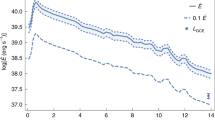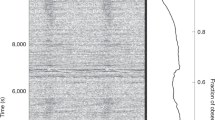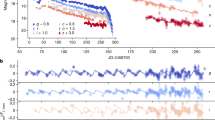Abstract
The recently discovered1 pulsar PSR1937 + 21 in 4C21.53 is remarkable for the shortness of its period (P = 1.5 ms) and for the length2 of its characteristic age, τP = P/2Ṗ ≳ 105 yr. The simple explanation that this is an ordinary supernova-formed pulsar but with an unusually weak magnetic field and hence weak magnetic dipole radiation (ref. 3), that is, B≊2×1010(τP/105 yr)−1/2(P/1.5 ms) G fits in with the position of the pulsar close to the galactic plane. We suggest here an alternative origin for the pulsar as being the remnant of one of the ‘galactic bulge’ X-ray binary stars.
This is a preview of subscription content, access via your institution
Access options
Subscribe to this journal
Receive 51 print issues and online access
$199.00 per year
only $3.90 per issue
Buy this article
- Purchase on Springer Link
- Instant access to full article PDF
Prices may be subject to local taxes which are calculated during checkout
Similar content being viewed by others
References
Backer, D., Kulkarni, S., Heiles, C., Davis, M. & Goss, M. IAU Circ. No. 3743 (1982).
Backer, D., Kulkarni, S. & Heiles, C. IAU Circ. No. 3746 (1982).
Ostriker, J. P. & Gunn, J.E. Astrophys. J. 157, 1395–1417 (1969).
Lewin, W. H. G. & Joss, P. C. Space Sci. Rev. 28, 3 (1981).
Van Paradijs, J. Nature 274, 650–653 (1978).
Ghosh, P., Lamb, F. K. & Pethick, C. J. Astrophys. J. 217, 578–596 (1977).
Papaloizou, J. & Pringle, J. E. Mon. Not. R. astr. Soc. 184, 501–508 (1978).
White, N. E. & Holt, S. S. Astrophys. J. 257, 318–337 (1982).
Bignami, G. F., Maraschi, L. & Treves, A. Astr. Astrophys. 55, 155–158 (1977).
Fabian, A. C., Blandford, R. D. & Hatchett, S. Nature 266, 512–513 (1977).
Paczynski, B. & Sienkiewicz, R. Astrophys. J. Lett. 248, L27–L30 (1981).
Bradt, H. V., Doxsey, R. E. & Jernigan, J.G. in X-ray Astronomy (eds Baity, W. A. & Peterson, L. E.) 3–70 (Pergamon, 1978).
Alpar, M. A., Cheng, A. F., Ruderman, M. A. & Shaham, J. Nature 300, 728–731 (1982).
Author information
Authors and Affiliations
Rights and permissions
About this article
Cite this article
Fabian, A., Pringle, J., Verbunt, F. et al. Do galactic bulge X-ray sources evolve into millisecond pulsars?. Nature 301, 222–223 (1983). https://doi.org/10.1038/301222a0
Received:
Accepted:
Issue Date:
DOI: https://doi.org/10.1038/301222a0
This article is cited by
-
Formation of Double Neutron Stars, Millisecond Pulsars and Double Black Holes
Journal of Astrophysics and Astronomy (2017)
-
Extended Corbet Diagram of HMXBs, LMXBs and radio pulsar binaries
Science China Physics, Mechanics and Astronomy (2010)
-
Pulsars: their origin and evolution
The Astronomy and Astrophysics Review (1989)
Comments
By submitting a comment you agree to abide by our Terms and Community Guidelines. If you find something abusive or that does not comply with our terms or guidelines please flag it as inappropriate.



